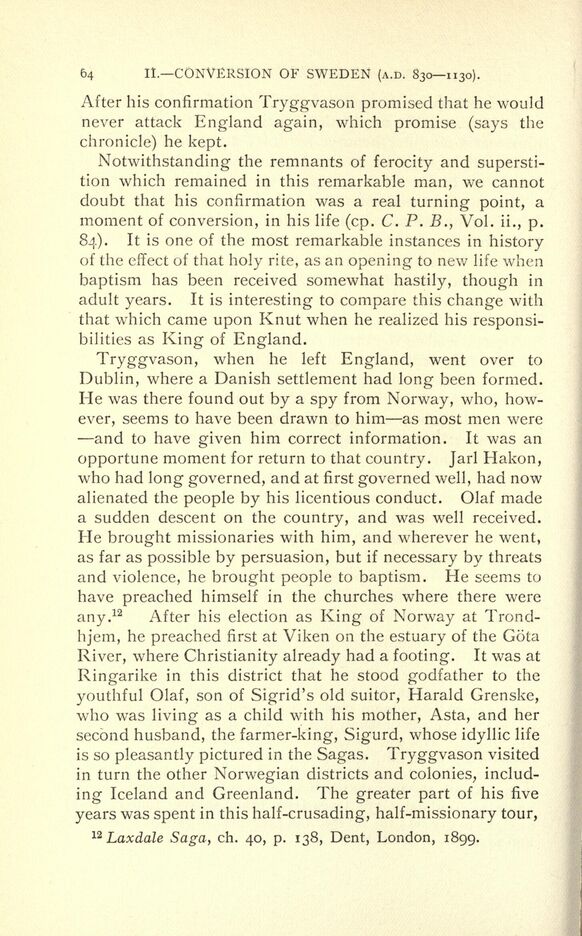
Full resolution (JPEG) - On this page / på denna sida - II. The Conversion of Sweden (830—1130 A.D.)

<< prev. page << föreg. sida << >> nästa sida >> next page >>
Below is the raw OCR text
from the above scanned image.
Do you see an error? Proofread the page now!
Här nedan syns maskintolkade texten från faksimilbilden ovan.
Ser du något fel? Korrekturläs sidan nu!
This page has never been proofread. / Denna sida har aldrig korrekturlästs.
64 II. CONVERSION OF SWEDEN (A.D. 8301130).
After his confirmation Tryggvason promised that he would
never attack England again, which promise (says the
chronicle) he kept.
Notwithstanding the remnants of ferocity and supersti
tion which remained in this remarkable man, we cannot
doubt that his confirmation was a real turning point, a
moment of conversion, in his life (cp. C. P. B., Vol. ii., p.
84). It is one of the most remarkable instances in history
of the effect of that holy rite, as an opening to new life when
baptism has been received somewhat hastily, though in
adult years. It is interesting to compare this change with
that which came upon Knut when he realized his responsi
bilities as King of England.
Tryggvason, when he left England, went over to
Dublin, where a Danish settlement had long been formed.
He was there found out by a spy from Norway, who, how
ever, seems to have been drawn to him as most men were
and to have given him correct information. It was an
opportune moment for return to that country. Jarl Hakon,
wr
ho had long governed, and at first governed well, had now
alienated the people by his licentious conduct. Olaf made
a sudden descent on the country, and was well received.
He brought missionaries with him, and wherever he went,
as far as possible by persuasion, but if
necessary by threats
and violence, he brought people to baptism. He seems to
have preached himself in the churches where there were
any.
12
After his election as King of Norway at Trond-
hjem, he preached first at Viken on the estuary of the Gota
River, where Christianity already had a footing. It was at
Ringarike in this district that he stood godfather to the
youthful Olaf, son of Sigrid s old suitor, Harald Grenske,
who was living as a child with his mother, Asta, and her
second husband, the farmer-king, Sigurd, whose idyllic life
is so pleasantly pictured in the Sagas. Tryggvason visited
in turn the other Norwegian districts and colonies, includ
ing Iceland and Greenland. The greater part of his five
years was spent in this half-crusading, half-missionary tour,
12
Laxdale Saga, ch. 40, p. 138, Dent, London, 1899.
<< prev. page << föreg. sida << >> nästa sida >> next page >>